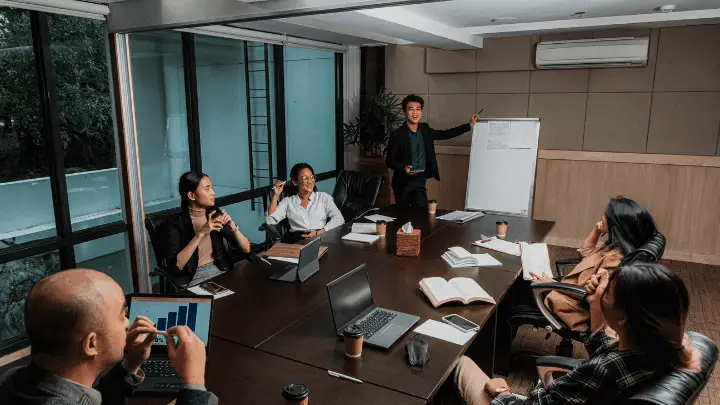Take a break from your workplace’s usual hustle and bustle and make time for a catch-up meeting.
Not only will these meetings save you time, but they’ll also help build relationships within your team. A catch-up meeting is an opportunity to get everyone on the same page.
Meetings like these are held to prepare for upcoming projects, discuss ongoing projects, and inform all parties of recent developments within the company. Hence, these meetings are a must for project managers and supervisors.
However, the success of these meetings relies heavily upon having the right expectations, plans, and execution before and after an actual meeting. So how do you plan a successful catch-up meeting?
Read on to learn more.
What is a catch-up meeting?
A catch-up meeting is a short meeting where the whole team gets together to review the progress on tasks, prioritize activities, and discuss anything that needs further attention.
It’s an essential part of successful collaboration in any workplace. Meetings like this are beneficial for many reasons.
Some of them are to review progress, assess upcoming tasks, and ensure deadlines are met. It also helps report successes and failures, identify areas for improvement, and brainstorm potential solutions.
They are also a great way to foster good relationships between team members. Regular catch-up meetings may seem like yet another task on your to-do list, but it enables teams to collaborate more effectively.
How to prepare for a catch-up meeting

Tips to prepare for a catch-up meeting will be classified into three; before (planning phase), during, and after the meeting.
How to plan a successful catch-up meeting
1. Choose the right time and place for your meeting
Timing and location are essential when getting the most out of a catch-up meeting. Scheduling your catch-up meeting for the right time is essential for keeping it productive.
Afternoon meetings tend to work best as they can easily be broken up into shorter chunks of time that accommodate everyone’s busy schedules.
Consider having an in-person meeting – physical proximity often leads to more meaningful relationships than virtual meetings.
As for location, pick one that’s comfortable and conducive to talking – somewhere quiet like a coffee shop or office conference room.
Avoid loud and distracting places like bars or restaurants. The right setting can help you get the most out of your catch-up meeting.
2. Come prepared with an agenda and goals
An agenda serves as a reminder for everyone involved so that everyone knows the topics being discussed. An agenda will also help focus the conversation and minimize distractions or potential tangents.
Goals are equally important, as they help prioritize tasks and ensure everyone is working towards the same objectives.
Setting clear objectives for the catch-up meeting will ensure that everyone is clear on what needs to be accomplished and how it should be accomplished.
3. Invite key stakeholders
It is important to identify who should be invited to the discussion. Ensure to include those closely involved with the project and those with decision-making power or influence.
Once you’ve identified the stakeholders that should be involved in the meeting, it’s important to send out invitations well in advance.
Give each person plenty of notice so they can plan and coordinate their schedules if necessary. It’s also helpful to include information about the agenda and topics for discussion, so attendees know what to expect.
4. Set ground rules and encourage active participation
Ground rules should be established to clearly define the purpose of the meeting and to provide guidance for how it should be conducted. Ground rules might be the time allocated for each person to speak, tone of voice, and constructive criticism, among others
Setting expectations for behavior, such as respecting each other’s opinions and avoiding personal attacks, will create an environment of openness and trust.
Active participation is key to a successful catch-up meeting. All parties involved should feel comfortable expressing their opinions and ideas and asking questions if they have them.
This will help move the conversation along and ensure that everyone has a chance to contribute.
During the Meeting
1. Discuss each agenda item
Before the meeting day, each stakeholder must have had a clue about the issues to discuss. During the catch-up meeting, each person will explain their opinions and why.
This will help all parties understand each other’s perspectives, making it easier for everyone to contribute something relevant to the discussion.
2. Ask questions and listen actively
It’s important that everyone feels comfortable enough to ask questions and contribute ideas, especially if there is any uncertainty or confusion over what needs to be done.
This can be done by asking open-ended questions such as “What have you noticed?” or “What would you suggest we do?”
This will allow everyone to understand their needs and how they may benefit from additional resources. It will also help them understand what is expected from them during the meeting.
3. Address any issues that arise
Any issues that arise during the meeting must be addressed immediately so that everyone feels included in the process and any disagreements are resolved quickly.
In this case, it may be helpful to create a list of all potential issues beforehand so they can be prioritized appropriately based on their importance.
For example: “How can we improve communication between our teams?”. When all parties can pay attention and address issues together, it’s easy to brainstorm a workable solution.
After the Meeting
1. Summarize decisions and outcomes
A good way to end a meeting is to summarize the decisions and outcomes. By doing so, project managers can keep track of what was discussed and agreed upon and who needs to be notified of any decisions made.
This is particularly useful if managers want to share their decisions with stakeholders later.
2. Follow up with stakeholders
Follow-up questions should be answered after the meeting so everyone can process their answers before their next meeting.
Project managers may refer to this post-meeting communication several times throughout a project or even several projects.
Following up is a good way for everyone involved in a project (internal or external) to stay informed about what’s going on and how things are moving. This can be done via email or in person if possible.
3. Record or document decisions and outcomes
Recording or documenting decisions and outcomes after a catch-up meeting is important to provide a reference for future projects.
Documenting each meeting’s results and decisions will allow project managers to use them as a strong reference for future projects.
Another reason why it is important to record or document decisions and outcomes after a catch-up meeting is to ensure accountability.
Finally, recording or documenting decisions and outcomes after a catch-up meeting will also help to maintain transparency between all parties involved in the project.
FAQs
When often should a catch-up meeting occur?
A catch-up meeting is best when held at reasonable intervals, such as every 3- 6 months. This allows everyone to stay in the loop and be better prepared for upcoming challenges.
Who should attend a catch-up meeting?
It’s generally best to invite all team members who will be involved in a project or who need to be aware of the progress and decisions being made.
How long does a catch-up meeting typically last?
Catch-up meetings typically last about 15 to 30 minutes. Nonetheless, this duration may vary depending on the size of the group and the number of updates or topics to discuss.
Conclusion
In the end, the most beneficial aspect of catch-up meetings is that they help keep a team feeling connected and knowledgeable.
While it may feel like a waste of time, successful project managers find that these meetings will improve efficiency in the long run. And with the information shared during these meetings, you can begin making informed decisions about your team’s direction.
Whether you have scheduled retros, impromptu check-ins, or any other type of meeting, remember their power to improve the work environment and increase efficiency.
A catch-up meeting with important soft skills can yield good results for a project manager. For more information, see the top soft skills for project managers.
I hope you have gained a deeper understanding of how these types of meetings can improve communication, collaboration, and avenues for discussing issues and concerns.
Thanks for your time.







